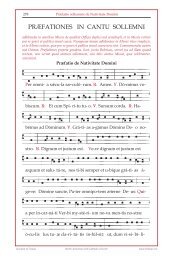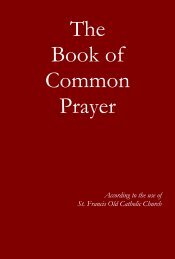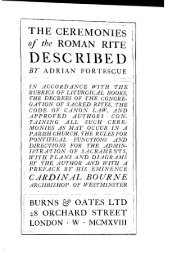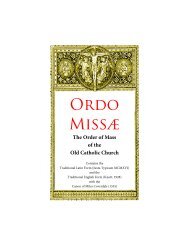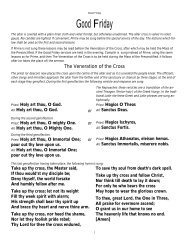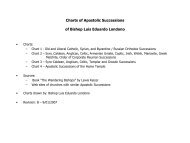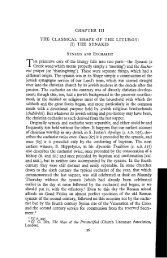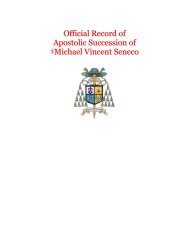Eucharist and Lord's Supper
Eucharist and Lord's Supper
Eucharist and Lord's Supper
You also want an ePaper? Increase the reach of your titles
YUMPU automatically turns print PDFs into web optimized ePapers that Google loves.
68 THE SHAPE OF THE LITURGY<br />
Once the new special connection between these two actions had been<br />
msde b the minds of the disciples, even on the first occasion after the last<br />
supper on which they held their chabUrah meal together, the wOl'ds 'Do<br />
this for the re-calling of Me', in conIlection with the bread at all events,<br />
became entirely unnecessary. As soon as it was certain that the chabUrah<br />
was going to continue to meet regularly-say soon after Pentecost-these<br />
words really became unnecessary in both cases. Even the longer text of<br />
Luke xxii. (the only authority other than I Cor. xi. to insert them at all)<br />
does so only with the cup, <strong>and</strong> there they appear to have been inserted in<br />
deliberate imitation of I Cor. xi. 25. The gospels of Matt. <strong>and</strong> Mark, put<br />
together more than a generation after the event, during which time the<br />
eucharist has been continuously the very centre of the life of the christian<br />
chabUrah, quite naturally omit them altogether. Their accounts of the last<br />
supper are not intended as mere reports of what occurred at the supper;<br />
they are designed to furnish the historical explanation of the origin of the<br />
established 'ecclesiastical' rite of the eucharist with which their readers are<br />
familiar. 1 They can <strong>and</strong> do take it for granted that the eucharist is something<br />
which has continued, <strong>and</strong> in details they reflect current liturgical<br />
practice. Thus the Syrian Gospel of Matt. (alone) has added the gloss that<br />
the partaking ofthe eucharist is 'for the remission of sins', which we shall<br />
find to be an abiding <strong>and</strong> peculiar characteristic of Syrian eucharistic<br />
prayers. So Mark has altered 'This cup is the New Covenant in My Blood'<br />
to 'This is My Blood of the New Covenant' to secure a closer parallel to<br />
'This is My Body'. The original form of the saying in I Cor. xi. 25 is<br />
inspired directly by the original circumstances of the clzaburah supper,<br />
where the bread is separated from the cup by the whole intervening supper,<br />
making a close parallelism unnecessary. There the cup of blessing <strong>and</strong> the<br />
Thanksgiving just said over it for the 'Old Covenant' are the immediate<br />
objects of the apostles' attention at the moment of our <strong>Lord's</strong> speaking.<br />
Hence, 'This cup is the New Covenant in My Blood.' The later Marean<br />
form bespeaks long <strong>and</strong> close association of the bread <strong>and</strong> cup together in<br />
christian underst<strong>and</strong>ing <strong>and</strong> practice, by its very assimilation of 'This is<br />
My Blood' to 'This is My Body'. The tradition as to what happened at the<br />
supper is still correct in essentials in both gospels, but it has been partially<br />
'ecc1esiasticised' in its interest; it has an explanatory as well as a strictly<br />
historical purpose.<br />
But in this Matt. <strong>and</strong> Mark differ from the 'tradition' which lies behind<br />
I Cor. xi. 24, 25. However S. Paul may be using it in his epistle, that was<br />
1 There seems to be real justice so far as concerns Matt. <strong>and</strong> Mark in K. L.<br />
Schmidt's remark (op. cit. col. 9) that 'We have before us in the accounts of the last<br />
supper a piece of tradition which in the general setting of comparative religion one<br />
can call an "aetiological cult-narrative" which serves the purpose of explaining a<br />
cult action customary in the society, or else a "cult-legend"'. (The question is<br />
'which?') Though S. Paul in I Cor. xi. is using his 'tradition' in precisely this<br />
aetiological way, its substance in itselfis something else, a narrative.



